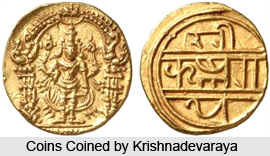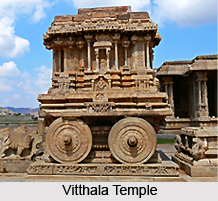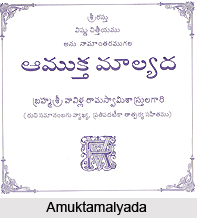 The Tuluva Dynasty is the third dynasty, that ruled Vijayanagar Empire. They were chiefs who feinted portions of coastal Karnataka. The Tuluva Dynasty was one of the decision-making lines of the Vijayanagara Empire of Southern India. The Vijayanagar empire accomplished it utmost splendor during this period with their most celebrated king was Krishna Deva Raya. Their reign comprised of five emperors from 1491 till 1570. They ruled approximately the whole of South India with Vijaynagar as their capital.
The Tuluva Dynasty is the third dynasty, that ruled Vijayanagar Empire. They were chiefs who feinted portions of coastal Karnataka. The Tuluva Dynasty was one of the decision-making lines of the Vijayanagara Empire of Southern India. The Vijayanagar empire accomplished it utmost splendor during this period with their most celebrated king was Krishna Deva Raya. Their reign comprised of five emperors from 1491 till 1570. They ruled approximately the whole of South India with Vijaynagar as their capital.
Tuluva Narasa Nayaka
Tuluva Narasa Nayaka (1491-1503 CE) was the able commander of the Vijayanagar army under the rule of Saluva Narasimha Deva Raya. Following the death of king Saluva Narasimha, the crown prince Thimma Bhupala was assassinated by an army commander. The faithful Narasa Nayaka then crowned the prince, Krishnadevaraya.
Viranarasimha Raya
Viranarasimha Raya (1505-1509 CE) was crowned the king of Vijayanagar Empire following the death of Tuluva Narasa Nayaka. The adolescent Krishnadevaraya was the king`s half brother. The demise of their competent father Tuluva Narasa Nayaka resulted in feudatories mounting in revolt ubiquitously. Primarily, Immadi Narasa Nayaka, the eldest son of Tuluva Narasa Nayaka became king and lasted the throne for two years prior to assassination. Viranarasimha Raya was coronated subsequently in 1505 and depleted years, combating revolt warlords. Yusuf Adil Khan of Bijapur tried to expand his sphere of authority to the south of the Tungabhadra.
The Vijayanagar regent was backed by Ramaraja of the Aravidu family and his son Thimma. With their aid, Adil Khan was overpowered and repressed. Adoni and Kurnool area became a part of Vijayanagar Empire. During this time, the chief of Ummattur was again in revolt and Viranarasimha Raya set out south to quell the rebellion, having placed Krishnadevaraya as the ruler in absence. Intensive efforts by Viranarasimha Raya to suppress the rebellion in Ummatur had mixed results. Portugal assisted king Raya`s forces in this conflict, providing horses and weaponry, in exchange seeking control of the port of Bhatkal.
Legend has it that, when on his deathbed, Viranarasimha Raya appealed to his minister Saluva Thimma (Thimmarasa) to blind Krishnadevaraya so that his own eight year old son could become king of Vijayanagar. Thimmarasa however fetched a pair of she-goat eyes to the king and informed him that he had Krishnadevaraya killed.
Krishnadevaraya
Krishnadevaraya (1509-1529 CE) was the most prominent king of Vijayanagara Empire. He presided over the empire at its summit. He is considered the hero of the people of Kannada and Telugu descent in South India and measured one of the eminent kings of India. Emperor Krishnadevaraya also received the designations of Andhra Bhoja and Kannada Rajya Rama Ramana. He was aided in the administration by the competent Prime Minist er Timmarusu. Timmarusu, was liable for the coronation of Krishnadevaraya. Krishnadevaraya revered Timmarusu as a father figure, but was the son of Nagala Devi and Tuluva Narasa Nayaka, an army commander under Saluva Narasimha Deva Raya, who soon after took charge of the sovereignty of the empire to prevent it from disintegration. The king`s coronation took place on the birthday of Lord Krishna while his original inscription dates back to July 26th. 1509 C.E. He built a fine-looking village near Vijayanagara called Nagalapura in reminiscence of his mother.
Military Campaigns and Foreign Relations: The reign of Krishnadevaraya was a magnificent episode in Vijayanagar history when its armies were successful everywhere. On instances, the king was known to change battle plans abruptly and turn a losing battle into victory. The first decade of his rule was one of long sieges, bloody conquests and victories. His main enemies were the Gajapatis of Orissa who had been at constant conflict since the rule of Saluva Narasimha Deva Raya, The Bahamani Sultans, though divided into five small kingdoms were still a constant threat, the Portuguese were a rising maritime power and hence controlled much of the sea trade. The feudatory chiefs of Ummatur, Reddys of Kondavidu and Velamas of Bhuvanagiri had time and again rebelled against Vijayanagar authority.
Success in Deccan: The annual affair of raide and plunder of Vijayanagar towns and villages by the Deccan sultans came to an end during the Rays`s rule. In 1509. Krishnadevarayas armies clashed with the Sultan of Bijapur at Diwani and sultan Mahmud was severely injured and defeated. Yusuf Adil Khan was killed and Kovilkonda was annexed. Taking advantge of the victory and disunity of the Bahamani Sultans, the Raya invaded Bidar, Gulbarga and Bijapur and earned the title "establisher of the Yavana kingdom" when he released Sultan Mahmud and made him de-facto ruler. All this happened by 1510.
War with Feudatories: The Emperor restrained local rulers, Reddys of Kondavidu and Velamas of Bhuvanagiri, and detained lands up to the Krishna River. Gangaraja, the Ummatue chief brawled Krishnadevaraya on the banks of the Kaveri and was overpowered. The chief later drowned in the Kaveri in 1512. The region was made a part of the Srirangapatna province. In 1516-1517, he pushed beyond the Godavari river.
War with Kalinga: Krishnadevaraya conquered the Gajapatis of Orissa who were in occupation of northern Andhra in five campaigns. The success at Ummatur asserted the required momentum to carry his campaign into to Telangana region, which was in control of Gajapati Prathaparudra. In 1513 the Vijayanagar army laid siege to Udayagiri fort, which lasted for a year before the Gajapati army was routed. Krishnadevaraya offered prayers at Tirupati thereafter along with his wives Tirumala Devi and Channa Devi. His kulaguru Vyasatirtha wrote many songs in praise of the King after this victory.
The Gajapati army was then met at Kondavidu where after a siege of a few months, Krishnadevaraya along with Saluva Timmarasa inflicted another defeat on Prathaparudra. Saluva Timmarasa took over as governor of Kondavidu thereafter. The Vijayanagar army then accosted the Gajapati army at Kondapalli area and laid another siege. This was the final defeat for the Gajapathi king who offered his daughter Jaganmohini in marriage to Krishnadevaraya. She became his third queen. He established cordial relations with the Portuguese, who set up the Portuguese Dominion of India in Goa in 1510. The Emperor obtained guns and Arabian horses from the Portuguese merchants. He also utilized Portuguese expertise in improving water supply to Vijayanagara City.
 Ultimate Conflict: The complicated alliances of the empire and the five Deccan sultanates meant that he was incessantly at war; in one of these campaigns, he crushed Golconda and detained its commander Madurul-Mulk, trampled Bijapur and its sultan Ismail Adil Shah and restored Bahmani sultanate to Muhammad Shah. The underscore of his invasions occurred on May 19, 1520 where he secured the fortress of Raichur from Ismail Adil Shah of Bijapur after a difficult siege during which 16,000 Vijaynagar soldiers were killed. The grateful emperor suitably rewarded the exploits of the chief military commander, Pemmasani Ramalinga Nayudu, during the battle of Raichur.
Ultimate Conflict: The complicated alliances of the empire and the five Deccan sultanates meant that he was incessantly at war; in one of these campaigns, he crushed Golconda and detained its commander Madurul-Mulk, trampled Bijapur and its sultan Ismail Adil Shah and restored Bahmani sultanate to Muhammad Shah. The underscore of his invasions occurred on May 19, 1520 where he secured the fortress of Raichur from Ismail Adil Shah of Bijapur after a difficult siege during which 16,000 Vijaynagar soldiers were killed. The grateful emperor suitably rewarded the exploits of the chief military commander, Pemmasani Ramalinga Nayudu, during the battle of Raichur.
During the campaign against Raichur, it is said that 703,000-foot soldiers, 32,600 cavalry and 551 elephants were used (See The battle of Raichur). Finally, in his last battle, he razed to the ground the fortress of Gulburga, the early capital of the Bahmani sultanate. His empire extended over the whole of South India. In 1524 he made his son Tirumalai Raya the Yuvaraja though the crown price did not survive for long. He was poisoned to death. Suspecting the involvement of Saluva Timmarasa, Krishnadevaraya had his trusted commander and advicer blinded.
Internal Affairs: Paes abridges the king`s approach towards matters of law and order by the sentence, "The king maintains the law by killing." Offences against belongings (designed to maintain stability) and for murder arrayed from cutting of a foot and hand for theft and beheading for murder (except for those occurring as a result of duel). Paes could not approximate the size of Vijaynagar as his view was obscured by the hills but estimated the city to be at least as large as Rome. Additionally, he measured Vijaynagar to be "the best provided city in the world" with a population of not less than a half a million. The empire was divided into a number of provinces often under members of the royal family and into further subdivisions. The official languages of the court were Telugu and Kannada.
Arts: Vitthala temple with musical pillars, Hoysala style multigonal base Hampi. The reign of Krishnadevaraya was an age of productive literature in many languages, while it was also known as a golden age of Telugu literature. Several Telugu, Sanskrit, Kannada and Tamil poets enjoyed the patronage of the emperor. Emperor Krishnadevaraya was assured in many languages. He patronized Kannada poets Mallanarya who wrote Veerasaivamrita, Bhavachintaratna and Satyendra Cholakathe, Chatu Vittalanatha who wrote Bhagavatha, Timmanna Kavi who wrote a eulogy of his king in Krishnaraya Bharata.
Vyasatirtha, the great saint from Mysore belonging to the Madhwa order of Udupi was his Rajguru who wrote countless songs in praise of his devoted king. Krishnadevarayana Dinachari in Kannada is a freshly discovered work. The record highlights the modern society during Krishnadevaraya`s term in his personal diary. However it is not yet clear if the king himself wrote the record. Krishnadevaraya patronised Tamil poet Haridasa. In Sanskrit, Vyasatirtha wrote Bhedojjivana, Tatparyachandrika, Nyayamrita (a work directed against Advaita philosophy) and Tarkatandava. Krishnadevaraya himself a proficient scholar wrote Madalasa Charita, Satyavadu Parinaya and Rasamanjari and Jambavati Kalyana.
Amuktamalyada: Krishnadevaraya inscribed Amuktamalyada in Telugu. In Amuktamalyada, Krishnaraya magnificently elucidates the pangs of division endured by Andal (one of the twelve bhakti era alwars) for her lover Lord Vishnu. He depicts Andal`s physical beauty in thirty verses, using metaphors of the spring and the monsoon. One of the main characters is Periyalwar, the father of Andal. Lord Vishnu commands Periyalwar to educate a king of the Pandya dynasty the path of knowledge to moksha. Amuktamalyada is also known by the name Vishnuchitteeyam, a reference to Vishnuchittudu, the Telugu name of Periyalwar. Several other short stories are included in Amuktamalyada in the course of the main story of Godadevi, the Telugu name of Andal, which is used throughout. Krishnarayalu was also well versed in Sanskrit, Tamil and Kannada. Jambavati Kalyanamu is his Sanskrit work. He also mentions of himself belonging to the Kuruba/Golla clan in Amuktamalyada.
Religion and Culture: Krishna Deva Raya esteemed all cults of Hinduism, although he individually inclined in favor of Sri Vaishnavismas and lavished on the Tirupati temple numerous objects of priceless value, ranging from diamond-studded crowns to golden swords. Additionally, he is known to have constructed the statutes of himself and his two wives within the temple complex. Krishna Deva Raya is respected, worshipped and idolized by Kurubas & Yadavas as one of the eminent personalities of their community. Krishnadevaraya, was formally, initiated into the Sri Vaishnava Sampradaya, by Panchamatha Bhanjanam Tathacharya, the Rajaguru, of those times. Article by U Vaidyanathan He also, equally, patronised Vyasatirtha, and other vedanta scholars of that time. He patronized poets and scholars in Kannada, Telugu, Tamil and Sanskrit.
Achyuta Raya
Achyuta Raya (1529-1542 CE) was a ruler of a Vijayanagara Empire of South India. He was the younger brother of Krishna Deva Raya, whom he succeeded in 1529. He patronised Kannada poet Chatu Vittalanatha and the great singer Purandaradasa(Father of Carnatic music) and the Sanskrit scholar Rajanatha Dindima II. Upon his death, the succession was disputed. His nephew, Sadashiva, finally became king while yet a child, under the regency of Aliya Rama Raya, a son-in-law of Krishnadevaraya.Achutha devaraya crowned Garikepati Viswanatha Naidu of Balija caste as the king of Madurai and thus Viswanatha Naidu became the founder of Madura dynasty.
Achyuthadevaraya not only crowned Alluri Sevappa Naidu of Balija caste as the king of Thanjavur but also gave his sister-in-law Murthimamba (His wife Thirumalamba`s own sister) in marriage to Sevappa naidu who became the founder of Thanjavur dynasty. The time when Achyuta Raya became the king was by no means a favorable one. The peace and prosperity of the halcyon days under Krishnadevaraya were coming to an end. Feudatories and enemies were waiting for an opportunity to bring down the empire. In addition, Achyuta Raya had to contend with the powerful Aliya Rama Raya, who was competing for the throne.
While the works of Nuniz speak very lowly of Achyuta Raya as being a king given to vices and cruelty, there is enough evidence to prove that the king was indeed noteworthy in his own right and fought hard to keep the prosperity of the kingdom alive. He had been handpicked by Krishnadevaraya himself as an able successor. Ismail Adil Shah of Bijapur invaded and captured the Raichur doab. However the Gajapati`s of Orissa and Quli Qutub Shah of Golconda were defeated and pushed back. Now Achyuta Raya along with his general Salakaraju Tirumala went on a southern campaign to bring the chiefs of Travancore and Ummatur under control. This they did successfully. Then they invaded the doab north of Tungabhadra and recaptured the forts of Raichur and Mudgal. The two Sanskrit works Achyutabhyudayam and Varadambikaparinayam describe the kings life and rule in detail.
 Throughout his rule, Achyuta Raya had to contend with the manipulations of Rama Raya who in his powerful capacity had replaced many of the faithfull servants of the Kingdom in high ranking positions with men of his own favour. On more than one occasion the Bahamani Sultans were brought in to play the role of mediator between the king and Ailya Rama Raya in the game of power sharing. This would further weaken the kingdom. In 1542 Aliya Rama Raya imprisoned Achyuta Raya in a coup and made Sadasiva Raya the new regent. Aliya Rama Raya became the de-facto king and let very little governance in the hands of Sadasiva Raya.
Throughout his rule, Achyuta Raya had to contend with the manipulations of Rama Raya who in his powerful capacity had replaced many of the faithfull servants of the Kingdom in high ranking positions with men of his own favour. On more than one occasion the Bahamani Sultans were brought in to play the role of mediator between the king and Ailya Rama Raya in the game of power sharing. This would further weaken the kingdom. In 1542 Aliya Rama Raya imprisoned Achyuta Raya in a coup and made Sadasiva Raya the new regent. Aliya Rama Raya became the de-facto king and let very little governance in the hands of Sadasiva Raya.
The Tiruvengalanatha Temple was built at Vijayanagara during his reign. It has become popularly known by his name as Achyutaraya Temple, rather than by the name of the deity Lord Venkateshwara to whom the temple was dedicated.
Sadasiva Raya
Sadasiva Raya was a king of Vijayanagara Empire. He came to power following the death of his uncle Achyuta Deva Raya in 1543. His coronation was made possible due to support of Aliya Rama Raya, son-in-law of Krishnadevaraya. Throughout his rule, the real power lay in the hands of the de-facto ruler Aliya Rama Raya.






































